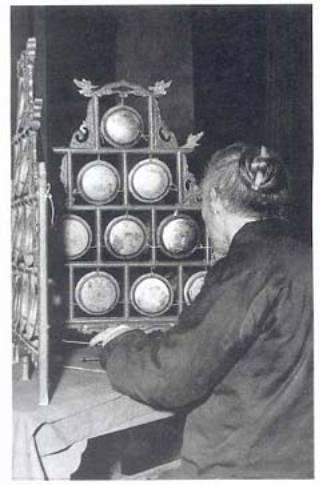The historical development of cloud gong
Our ancestors choreographed small gongs with different pitches very early and used them in musical practice. In the Song Dynasty painter Su Hanchen's "Trademan Picture", a merchantman hangs several musical instruments, one of which is a ten-faced cloud gong.
In the Yuan Dynasty more than 600 years ago, cloud gongs were not only popular among the people, but also used in court banquets. Made of bronze, it is a small gong thirteen, the same wooden frame, with a long handle under it, the left hand holds it, and the right hand hits it with a small mallet." This is also the earliest record found in the literature.
Yuan Dynasty cloud gongs were also used in religious music. For example, in the Yuan Dynasty mural "Playing Music" in Yongle Palace in Yongle Town, Ruixian County, Shanxi Province and the decorative paintings in the dougong room of Sanqing Palace, there are pictures of playing cloud gongs in the palace. The murals reflect Taoist life, indicating that cloud gongs were used in Taoist music in the early days. From the historical records and murals of the Yuan Dynasty, there are ten, thirteen and fourteen-tone cloud gongs.

In the early Qing Dynasty, the cloud gong had developed to twenty-four tones, and "Yangzhou Huafang Lu" recorded that the fourteen-tone cloud gong was popular in Fujian. According to the "Draft of Qing History", cloud gongs have been widely used in court music of the Qing Dynasty in the royal guard music, Danbi music, Zhonghe Qing music, Daoyin music, Naoge and Naoge Qingyue, Kaige, Qingshen joy , giving feasts, etc.
In the Qing Dynasty, there was a handed down of "Cloud Gongs", which was collected by Mr. Mei Lanfang, a famous Peking Opera performing artist. "Cloud Gong" was given by Mr. Mei to his friend Mr. Song. The "Spectrum" introduces in detail the temperament of the cloud gong and the specifications and dimensions of each side of the cloud gong.
"Yuan Shi·Liyuezhi" records: "Yun'ao made bronze gongs as thirteen small gongs, the same wooden frame, with a long handle under it, the left hand holds it and the right hand hits it with a small mallet." However, from the Yuan murals of Shanxi Yongle officials, The small gongs used in each cloud gong in the Yuan Dynasty were not limited to thirteen, but also used ten and fourteen. Since the Ming and Qing dynasties, a cloud gong that has been popular for a long time is composed of ten small gongs.
But there are occasional exceptions. For example, in the early Qing Dynasty, there were 24 cloud gongs paid in full, and later in Fujian there were 14 cloud gongs paid in full. According to the "Draft of Qing History", cloud gongs are used for the music of the imperial guard of honor, the music for sacrificing silkworms, Danbi music, Zhonghe Qingle, Daoyin music, Naoge and Naoge Qingle, triumphant song, celebration of the gods, and feasts. Music, Mongolian music, the music of the Panchen Lama (called Cangqing).
Traditional cloud gongs are mostly composed of ten small gongs. The surface of the gong has no umbilical cord, and the edge is fixed by the edge of the gong perpendicular to the surface of the gong. Small holes are drilled on the edge of the gong. ) is not commonly used, so it is also known as the "Nine Sound Gong".

The small gongs are the same size, with a face diameter of 8 cm. Due to the difference in thickness, they can emit different sounds. The timbre is clear and clear, with a range of g1-d3, a1-d3, and one more octave. The ten-sided small gongs are tied on a wooden frame. The frame is divided into three parts, the left and right fans are divided into three grids, and the middle fan is four grids. The phonemic arrangement of cloud gongs varies with regions, genres and occasions of use.
There are two ways of playing, one is holding the wooden handle in the left hand or pressing the handle against the table, and the right hand percussion with a single hammer (bamboo handle, horn head), this way of playing is less expensive, the other is Remove the handle of the wooden frame, raise the upper end of the three wooden lattices, place it on the table obliquely, and tap with both hands. In the instrumental ensembles such as "Sunan Chuiting" and "Juban Gong and Drum", Yun Gong plays the backbone of the melody and has a strong color. "Xi'an Drum Music" uses two cloud gongs, each mounted on a special base, standing face to face at a certain angle on the table, and percussion by one person, it becomes a unique double cloud gong performance.
Since the 1960s, musicians and musical instrument developers have continued to reform the traditional cloud gong. In 1963, the Jinan Army Avant-garde Art Troupe, Zhao Xing, cooperated with Shandong Zhoucun Ludong Musical Instrument Factory. On the basis of the folk nine-tone gongs, referring to the chimes of the Confucian Temple in Qufu, Shandong, they first made twenty-nine-tone cloud gongs with a range of g-f3. Thirty-six-tone cloud gong produced by Beijing National Musical Instrument Factory, range #c-c3. Tian Dezhong of the Shenyang Military Region Art Troupe cooperated with Ludong Musical Instrument Factory to produce a thirty-eight-tone cloud gong based on the twenty-nine-tone cloud gong, with a range of c1-c4. In addition, there are fifteen, twenty-six and thirty-seven sound cloud gongs.
 渝公网安备 50010702504639号
渝公网安备 50010702504639号